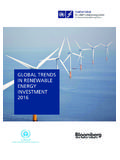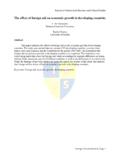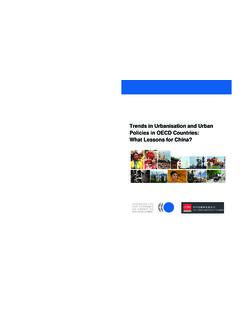Transcription of PUBLIC SPENDING IN DEVELOPING COUNTRIES: …
1 1 PUBLIC SPENDING IN DEVELOPING countries : trends , DETERMINATION, AND IMPACT Shenggen Fan and Anuja Saurkar1 1. INTRODUCTION Government SPENDING patterns in DEVELOPING countries have changed dramatically over the last several decades. Thus, it is important to monitor trends in the levels and composition of government expenditures, and to assess the causes of change over time. It is even more important to analyze the relative contribution of various expenditures to production growth and poverty reduction, as this will provide important information for more efficient targeting of these limited and often declining financial resources in the future. There have been numerous studies on the role of government SPENDING in the long-term growth of national economies (Aschauer 1989; Barro 1990; Tanzi and Zee 1997). These studies found conflicting results about the effects of government SPENDING on economic growth. Barro was among the first to formally endogenize government SPENDING in a growth model and to analyze the relationship between size of government and rates of growth and saving.
2 He concluded that an increase in resources devoted to non-productive (but possibly utility-enhancing) government services is associated with lower per capita growth. Tanzi and Zee also found no relationship between government size and economic growth. On the other hand, Aschauer s empirical results indicate that non-military PUBLIC capital stock is substantially more important in determining productivity than is the flow of non-military or military SPENDING , that military capital bears little relation to productivity, and that the basic stock of infrastructure of streets, highways, airports, mass transit, sewers, and water systems has most explanatory power for productivity. Many studies also attempted to link government SPENDING to agricultural growth and poverty reduction (Elias 1985; Fan et al. 2000; Fan et al. 2004; Fan and Pardey 1998, and Lopez 2005). Most of these studies found that government SPENDING contributed to agricultural production growth and poverty reduction, but different types of SPENDING may have differential effects on growth and poverty reduction.
3 The purpose of this study is to review and analyze the trends and causes of change in government expenditures and their compositions in the DEVELOPING world, and to develop an analytical framework for determining differential impacts of various government expenditures on economic growth. We first review trends in and the composition of government expenditures across DEVELOPING regions of Africa, Asia, and Latin America. We then model determinants of composition of government expenditures. Next, we model effects of government expenditures on gross domestic product (GDP) growth by estimating a GDP function and estimate the impact of various PUBLIC capitals on agricultural GDP growth. We conclude with the study s major findings. 1 The authors thank Annie White and Neetha Rao for able research assistance. 2 2. GOVERNMENT SPENDING : trends , SIZE, AND COMPOSITION Measures Total expenditure is broken down into various sectors following the International Monetary Fund s Government Finance Statistics (GFS) Yearbook sectors.
4 This study concentrates on six sectors, namely agriculture, defense, education, health, social security, and transportation and communication. Appendix Table provides further description on these sectoral definitions. To convert expenditures, denominated in current local currencies, into international dollar aggregates expressed in base year (2000), prices were first deflated from current local currency expenditures to a set of base year prices using each country s implicit GDP deflator. We then used 2000 exchange rates measured in 2000 purchasing power parity reported by the World Bank Indicators (2006) to convert local currency expenditures measured in terms of 2000 prices into a value aggregate expressed in terms of 2000 international dollars. We included 44 DEVELOPING countries from three regions in our analysis, partly reflecting the availability of data and partly because these countries are important in their own right while representing broader rural development throughout all DEVELOPING countries .
5 The 17 countries included for Africa are Botswana, Burkina Faso, Cameroon, C te D Ivoire, Egypt, Ethiopia, Ghana, Kenya, Malawi, Mali, Morocco, Nigeria, Togo, Tunisia, Uganda, Zambia, and Zimbabwe. We included 11 countries from Asia: Bangladesh, China, India, Indonesia, Korea, Malaysia, Myanmar, Nepal, Philippines, Sri Lanka, and Thailand. For Latin America, we included 16 countries : Argentina, Belize, Bolivia, Brazil, Chile, Colombia, Costa Rica, Dominican Republic, Ecuador, El Salvador, Guatemala, Mexico, Panama, Paraguay, Uruguay, and Venezuela. In 2002, these countries account for more than 80% of both total GDP and agricultural GDP in DEVELOPING countries . The data coverage for the Asian countries includes both central and sub-national expenditure in the GFS. Many of the African countries have minimal local government expenditures or lack sub-national government entities.
6 In addition, expenditures by the local governments are central government transfers that are reflected in the central government budget. However some Latin America countries have made significant decentralization efforts in the recent decades. These efforts have been captured in the data for the large countries such as Argentina, Bolivia, Chile, Colombia, Mexico and Paraguay. But for smaller countries in the region, some of the local government expenditures may have not been captured by the IMF dataset. Budgetary support on social sectors to local NGOs is not captured by the data. Finally, we geometrically extrapolated data for countries whose values were missing to ensure continuity of data (see Appendix Table for a summary of these extrapolations by country). Size of Government SPENDING Over the past two decades, total government expenditures, in the 44 DEVELOPING countries considered in this study, experienced overall growth.
7 During the 1980s, expenditures increased from $993 billion in 1980 to $1,595 billion in 1990, with an annual growth rate of percent 3(Table ). In the 1990s, governments increased their SPENDING power by percent per year. By 2000, total government expenditures increased to $2,748. billion. They further reached $3, billion in 2002. Therefore, we have seen accelerated growth in government expenditures in DEVELOPING countries . However, amongst DEVELOPING countries , regional deviations from these averages were quite marked. Across all regions, Asia experienced the most rapid growth, while Africa and Latin America increased at a much slower pace. In fact, most of the increase in total government expenditures came from Asia, accounting for 67 percent of total expenditures in 2002, up from 50 percent in 1980. This is due to the fact that most Asian countries experienced rapid growth in per capita GDP.
8 With the exception of Sri Lanka and Myanmar, all countries in the region at least doubled their total expenditures for the period 1980 2002. Republic of Korea and Bangladesh had the most rapid growth over 1980 2002, followed by India and Thailand. For African countries , expenditures grew at percent over 1980 2002. Growth was much slower in the 1980s, at percent per annum. In fact, there was a brief contraction after 1982, and it was not until 1986 that total government expenditures recovered to 1982 levels, when many African countries implemented macroeconomic structural adjustments. However, during the 1990s African countries gained momentum in expanding government expenditures, growing at percent per annum. Botswana had the most rapid growth, mainly due to the outstanding performance of its national economy: more than 10 percent growth per annum during 1980 2002.
9 Latin American countries had the slowest growth in SPENDING between 1980 and 2002. The share of the 16 countries of the total expenditure reduced from 38% in 1980 to 26% in 2000. The growth rate in the 1980 was 4% and much less in the 1990s with Many countries in the region including large ones like Argentina and Brazil were faced with structural adjustment programs which led lower SPENDING in the social sectors and overall government expenditure. Total government expenditure as a percentage of GDP measures the amount a country spends relative to the size of its economy. For countries in this study, the percentage increased from 19 percent in 1980 to 22 percent in 2002. 2 On average, DEVELOPING countries spend much less than developed countries . For example, total government outlays as a percentage of GDP in Organization for Economic Cooperation and Development (OECD) countries range from 27 percent in 1960 to 48 percent in 1996 (Gwartney et al 1998), compared to 13 35 percent in most DEVELOPING countries (For detailed information on each country, refer to Appendix Table ).
10 For Asia, the percentage increased from 19 percent in 1980 to 20 percent in 2002. There is a strong correlation between the level of economic development and government SPENDING power in this region, with the exception of Sri Lanka. In 2002, Myanmar spent the least, only 8 percent of its GDP, while the rest of the Asian countries spent 14 25 percent of their GDP. India has been SPENDING 17 percent of its GDP since it liberalized its economy in the 1990s whereas China has accelerated its SPENDING since 2000. Thailand has also accelerated its SPENDING to a quarter of its GDP. 2 Since the weighted commonly calculated at the regional and global level may bias towards large countries , we also report unweighted average at the regional and global levels. 4 Surprisingly, among the three regions, Africa spent the most as a percentage of GDP. Government SPENDING as a percentage of GDP was roughly 27 34 percent over the last two decades, almost 10 percentage points higher than Asia and Latin America.














